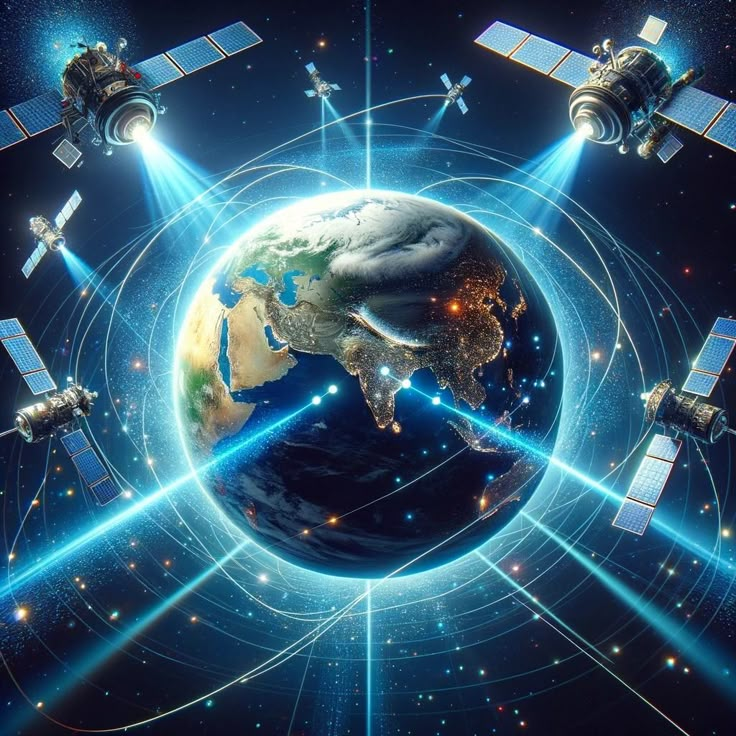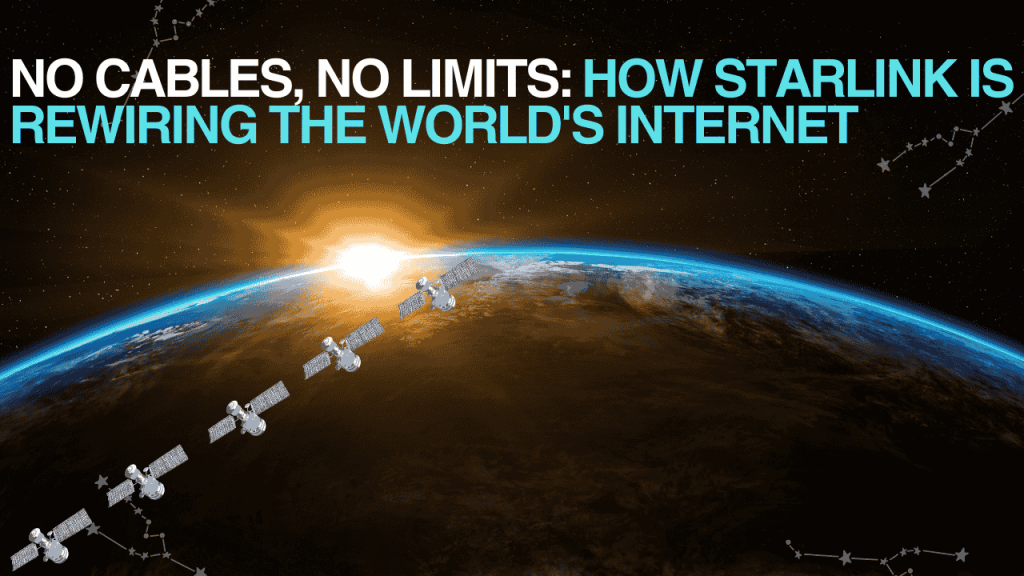Table of Contents
ToggleIntroduction: The Dawn of Satellite Internet Revolution
For decades, reliable internet access required physical infrastructure – fiber optic cables, telephone lines, or cellular towers. But in 2019, something extraordinary happened: Elon Musk’s SpaceX launched the first batch of Starlink satellites, initiating a global connectivity revolution that’s challenging everything we know about internet delivery.
Today, as thousands of Starlink satellites in the sky form a mega-constellation, they’re bringing high-speed internet to places where laying cables was impossible or prohibitively expensive. From remote Alaskan villages to Ukrainian war zones, from research vessels in the Pacific to mountaineers on Everest, Starlink is proving that the future of internet access comes from above rather than below.
This comprehensive guide will explore
- The groundbreaking technology behind Starlink satellites
- How Elon Musk’s vision differs from traditional ISPs
- What those moving lights in the night sky really mean
- Real-world applications changing lives globally
- The controversies and challenges ahead
- What the future holds for satellite internet

Understanding Starlink: The Technology Behind the Revolution
The Satellite Constellation
Unlike traditional geostationary satellites that orbit at 35,786 km, Starlink satellites operate in low Earth orbit (LEO) at just 340-550 km altitude. This strategic positioning reduces latency from 600ms to 20-40ms – comparable to ground-based broadband.
SpaceX has deployed over 5,000 functional satellites as of 2024, with plans for up to 42,000. Each 573 lb (260 kg) satellite:
- Uses ion thrusters for station-keeping
- Features 4 phased-array antennas for simultaneous connections
- Has laser interlinks for satellite-to-satellite communication
- Carries sunshades to reduce reflectivity (more on this later)
Ground Infrastructure
The system requires three key components:
- User Terminals (“Dishy McFlatface”): $599 self-aligning phased-array antennas
- Ground Stations: Over 100 globally, connecting satellites to terrestrial internet
- Network Operations Centers: SpaceX facilities managing the constellation
Frequency Bands Used
Starlink operates across multiple bands:
- Ku-band (12-18 GHz): Primary user connections
- Ka-band (26.5-40 GHz): Future high-capacity links
V-band (40-75 GHz): Experimental ultra-high-speed
Starlink in the Sky: What You're Actually Seeing
The “String of Pearls” Phenomenon
Those mesmerizing Starlink in sky sightings occur when:
- Newly launched satellites (in “train” formation) ascend to operational orbit
- Sunlight reflects off their solar panels at dawn/dusk
- They appear as 20-30 bright dots moving in unison
Visibility Patterns
- Best viewing times: 1-2 hours after sunset or before sunrise
- Tracking tools: Apps like “Find Starlink” predict visible passes
- Duration: Typically visible for 5-10 minutes per pass
The Astronomy Controversy
While beautiful to casual observers, astronomers raise concerns:
- Light pollution: Satellites interfere with long-exposure astrophotography
- Radio interference: Potential impact on radio astronomy
- Space debris risk: Increased collision potential in crowded LEO
SpaceX’s mitigation efforts include:
- DarkSat: Experimental low-reflectivity coating
- VisorSat: Sunshades to reduce brightness by 50%
- Automated collision avoidance: Using onboard propulsion
Global Impact: Who Benefits Most from Starlink?
Connecting the Unconnected
- Rural Communities: 37% of the world lacks broadband access. Starlink serves:
- Alaskan villages saving $1,200/month on slow VSAT
- Mongolian herders maintaining nomadic traditions with connectivity
- Amazon tribes accessing telemedicine
- Emergency Response:
- Ukrainian military communications during Russian attacks
- Australian bushfire coordination
- Hurricane Ian disaster recovery in Florida
- Transportation:
- 100+ cruise ships now offer Starlink Wi-Fi
- Hawaiian Airlines providing free in-flight streaming
- Truckers maintaining connectivity on remote routes
Business Applications
- Offshore Industries: Oil rigs saving $50,000/month on legacy systems
- Digital Nomads: RV users working remotely from national parks
- Financial Sector: Low-latency trading in emerging markets
Military and Government Use
- Pentagon contracts: $1.9B for secure military Starlink versions
- Taiwanese defense: Preparing for potential Chinese blockade
- Polar research: NSF Antarctic stations now streaming 4K video
Technical and Ethical Challenges
Performance Limitations
- Weather sensitivity: Heavy rain/snow can disrupt signals
- Obstruction requirements: Needs 100° clear view of the sky
- Capacity constraints: Speeds may slow during peak usage
Space Sustainability Concerns
- Orbital debris: 3 near-misses with Chinese space station reported
- Spectrum allocation: ITU debates fair frequency distribution
- Kessler Syndrome risk: Potential cascade of collisions
Economic and Political Barriers
- Cost prohibitive: $120/month unaffordable in developing nations
- Regulatory hurdles: Banned in South Africa, restricted in India
- Market competition: Amazon’s Project Kuiper launching 3,236 satellites
The Future According to Elon Musk
Upcoming Innovations
- Gen2 Satellites: Larger, more powerful models
- Direct-to-Cell: 2024 smartphone connectivity tests
- Starship Deployment: 400 satellites per launch (vs. 60 currently)
Long-Term Vision
- Mars colonization: Starlink profits funding interplanetary internet
- Lunar outposts: Proposed moon base connectivity
- Global 5G alternative: Potential to bypass traditional telecoms
Price Reduction Roadmap
- 2025 target: $50/month for basic service
- Terminal cost: Aiming for $200 consumer model
Enterprise solutions: Maritime/Aviation packages
Starlink Pricing Breakdown: Is It Worth the Cost?

Starlink’s pricing model has evolved since its 2020 beta launch. Here’s the 2024 cost structure:
Plan | Monthly Fee | Hardware Cost | Best For |
Residential | $120 | $599 | Homes in rural areas |
Roam (Mobile) | $150 | $599 | RVs, boats, nomads |
Business | $250 | $2,500 | Remote offices |
Maritime | $250 | $2,500 | Ships & oil rigs |
Aviation | Custom | $15,000+ | Private jets |
Key Notes:
- SpaceX Starlink offers no long-term contracts—cancel anytime.
- Discounts available for low-income users via FCC’s Affordable Connectivity Program.
- Global pricing varies:
- UK: £75/month
- Australia: AU$139/month
- Brazil: R$530/month
Is It Worth It?
✔ For rural users: Cheaper than satellite competitors like HughesNet ($100/month for 25Mbps).
❌ For urban users: Fiber/5G remains faster and cheaper
SpaceX’s Role: More Than Just Rockets

Elon Musk’s SpaceX isn’t just launching rockets—it’s redefining internet economics:
- Reusable Falcon 9 rockets cut satellite deployment costs by 60%.
- Weekly launches: 60+ Starlink satellites added per mission.
- Vertical integration: SpaceX builds satellites, rockets, and user terminals in-house.
2024 Launch Stats:
- Total satellites deployed: 5,200+
- Target: 42,000 by 2027
Competitor Comparison
Provider | Satellites | Speed | Price/Month |
Starlink | 5,200+ | 50-200Mbps | $120 |
OneWeb | 600+ | 50-150Mbps | $300+ |
Amazon Kuiper | 0 (testing) | TBD | TBD |
Starlink at War: How Satellite Internet is Changing Modern Warfare
Beyond civilian use, Starlink has become a game-changer in modern warfare. The Pentagon has invested $1.9 billion in Starlink’s secure “Starshield” program, featuring:
- Encrypted communications for frontline troops
- GPS-independent navigation systems
- Rapid deployment in conflict zones (as demonstrated in Ukraine)
- Anti-jamming capabilities that outperform traditional systems
Recent reports reveal special forces using pocket-sized Starlink terminals for real-time drone operations. However, this militarization raises ethical questions about space weaponization and has prompted China to accelerate its own satellite internet projects.
Light Speed Internet: The Laser Tech Behind Starlink 2.0
Starlink’s newest satellites feature revolutionary “space lasers” that:
- Enable satellite-to-satellite communication at light speed
- Reduce reliance on ground stations by 30%
- Provide 100Gbps crosslinks (faster than undersea cables)
- Allow polar coverage without infrastructure
These lasers use precision optics that can maintain connections while satellites move at 17,000 mph. SpaceX recently demonstrated this by streaming 4K video between satellites over Antarctica – a capability that could eventually create an “orbital internet backbone” independent of Earth-based systems.
Work From Anywhere: How Starlink Powers the Nomad Economy
The RV-friendly “Starlink Roam” plan has created a new class of location-independent workers who:
- Maintain Zoom calls from national parks ($150/month plan)
- Get 50-150Mbps speeds in moving vehicles (with flat-mount antennas)
- Use less power than traditional satellite setups (45-75 watts)
Real-world examples include: - Vanlifers editing videos in Utah deserts
- Sailors running e-commerce businesses mid-ocean
- Disaster responders setting up pop-up offices
The main limitation remains the need for occasional recalibration during long-distance travel.
Green Internet? The Environmental Cost of Starlink
The constellation presents a complex sustainability picture:
Benefits:
- Replaces diesel generators in remote areas (1 Starlink terminal = 5 fewer tons CO2/year)
- Enables climate monitoring via IoT sensors
- Uses solar-powered satellites
Concerns:
- Rocket launches contribute to atmospheric pollution
- Potential space debris (though satellites are designed to fully deorbit)
- Light pollution’s effect on astronomy
SpaceX claims each Falcon 9 launch has a smaller carbon footprint than a transatlantic flight, while astronomers note Starlink satellites now appear 80% dimmer after design modifications.
Beyond Broadband: Starlink's Most Bizarre Applications
Beyond conventional applications, users have adapted Starlink for:
- Wildlife conservation: Anti-poaching teams in Africa use motion sensors with Starlink backhaul
- Arctic research: Scientists stream live glacier melt data
- Off-grid crypto mining: Some miners use mobile setups
- Film production: Documentarians broadcast raw footage from jungles
- Private islands: Resorts bypass undersea cable costs
One yacht owner even created a floating Starlink hotspot serving passing ships 50 miles offshore. These unconventional applications demonstrate how the technology enables connectivity in ways traditional ISPs never imagined.
Conclusion: Rewiring Our Connected Future
As Starlink satellites continue filling the sky, they’re not just creating celestial light shows – they’re fundamentally altering global communication paradigms. While challenges remain, Elon Musk’s vision of “internet without borders” is materializing faster than skeptics predicted.
The implications are profound:
- Education: Remote students accessing MIT OpenCourseWare
- Healthcare: Telemedicine reaching refugee camps
- Economy: Enabling digital entrepreneurship worldwide
As we stand at this technological inflection point, one truth becomes clear: the internet of tomorrow won’t come through cables buried in the ground, but through constellations dancing across the sky.
- The Future of PS5 with AI: How Artificial Intelligence is Revolutionizing Gaming and Redefining Next-Gen Gaming Technology
- How to Rank Your Business on Google Maps in the USA #1
- World Capital of AI and Crypto USA: The Era of Innovation and Market Impact 2025
- How Digital Marketing Can Transform Small Businesses in the USA
- Common SEO Issues and Solutions USA
- India Based Digital Services for USA Clients
- Common Web Design Errors USA
- Mobile First Website Design
- Digital Marketing Challenges for USA Businesses




it’s awesome and detailed information